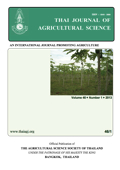Genetic Variation for Yield and some Yield and Growth Traits in Faba Bean (Vicia Faba L.) Genotypes in Two Sowing Date
Main Article Content
Abstract
Planting time is crucial in many farming systems because early or late sowing in the growing season expose the crop to drought, adverse temperature, pests and diseases attack. An experiment comprised of 12 treatment combinations, six genotypes (autochthonous landrace from Guilan, Barrakat, France, autochthonous landrace from Lorestan, FILIP3 and FILIP5) and two dates of sowing (1 December 2012 and 2 March 2013) was carried out to determine the effect of planting date on faba bean growth and yield and to estimate genetic parameters for studied traits. The experiment was laid out in a split plot design based on randomized complete block design with three replications. The main plots were sowing date and the sub plots were six faba bean genotypes. Analysis of variance indicated that there were significant effects of planting date, genotype and interaction effects of two factors on all of the studied traits. The highest seed yield (3,208 kg/ha), was resulted from sowing on Dec. 1 with the autochthonous landrace genotype from northern Iran. The genotypes in this study exhibited variable yield performances under tow sowing dates. The results of correlation analysis indicate that higher seed yield noticed with sowing in two times can be related to significantly higher number of stems per plant, number of pods per plant, seed length and seed width. High phenotypic coefficient of variation (PCV) was observed for hundred seed weight, number of pods per plant, pod length, seed length and seed width in first sowing date. Broad sense heritability (h2) was generally high for most studied traits. The genotype 1 (autochthonous landrace from north of Iran) scored the high values of yield per kg ha-1 and hundred seed weight in two sowing date, indicating the availability of using it at late planting.


